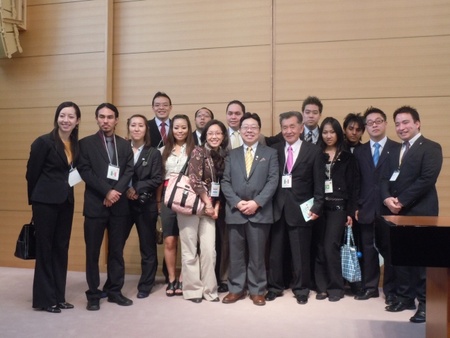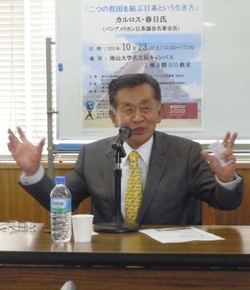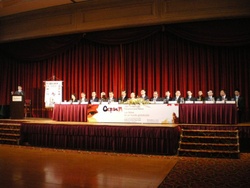Any Nikkei leader in the Americas either personally knows or has heard of Carlos Kasuga because of his achievements as a businessman in Mexico, or because of his role in the Nikkei Panamerican Association. Not many are familiar, however, with the story of his migration from Japan to Mexico. According to the Encyclopedia of Nikkei of the American Continent Americano1, it all began with Enomoto’s efforts to establish a settler colony in Chiapas in 1897. Enomoto was quite the celebrity, having served as Minister of Foreign Relations in the Meiji government, although he had initially fought against the Meiji Restoration as one of the Tokugawa milirary leaders stationed at Fort Goryokaku in Hokkaido, Hakodate.
Although Enomoto’s plan in Mexico proved unsuccessful, thousands of Japanese arrived in Mexico and worked on the railroads and in the coal mines. Oppressive labor conditions, however, pushed many to migrate to the United States2. During the Mexican Revolution of 1910, the Japanese were subject to looting and acts of violence, and, when World War II broke out, were forced to move to the federal capital, Mexico City, so they could be monitored in a specific geographical area. And a few leaders of the Japanese community were arrested. In the post-war period the second-generation of Japanese began to rebuild their associations, schools, and recreational centers. This forced move to the city allowed the Japanese to find more opportunities in commerce, as professionals, and in the service sector, which distinguishes Japanese immigration to Mexico from Japanese immigration to Peru or Brazil, where most workers ended up in agriculture.
Despite the institutional crisis that caused disrupture in the Japanese community, many were successful in forming a Japanse-Mexican Association, followed by the famous bilingual Japanse-Mexican School. Most likely it was the small number of Japanese in Mexico who shared the same historical circumstances and who faced many of the same adversities that made it easier for the community to overcome any differences and develop more integrated institutions at the local level. We do not want to discount, however, the many relationships that Kasuga had established with the business and political sectors, which also facilitated many of these accomplishments3. Today, there are 17,000 in the Nikkei community, and Carlos Kasuga remains an important figure.
The “Soft Power and Making Peace” Study Group at the University of Nanzan, Nagoya, which is headed by Professor Sachie Asaka who had studied in Mexico as a young woman and is currently researching the transnational role of the Nikkei, invited Carlos Kasuga in October 2010 to give a paper entitled, “A Nikkei’s Two Countries.”4 Kasuga was born in a small town located some 600 kilometers from the capital city, and, during World War II, much like many Japanese families, was obliged to relocate in and around Mexico City, an act that he recalls with humor because it allowed him to attend college. Keep in mind that in order to be respected as a Nikkei, as a Nikkei businessman or leader of an organization, it is necessary to be 60% Mexican and 60% Japanese. With this 120% a Nikkei can open doors even in the most difficult situations. It must be emphasized that a second-generation Japanese has to exert such effort and sacrifice in order to overcome prejudice and ignorance.
With his well-rounded experience, Kasuga recalls that he was the “first dekasegui” of the post-war generation. In 1956 he arrived in Japan as a student without a scholarship to study in the University of Sophia. A fortuitous meeting, however, at an industrial machiney fair made him a “worker” at a production plant where he learned to repair the machines. It was a time when consumer spending was quite limited5. His positive attitude for new and different things made him the exclusive representative of the Japanese dairy company Yakult, where he built one of the most important plants in all of Latin America6.
Regarding his work philosophy and attitude toward life, it should be said that it is difficult for any society to enjoy development and have a strong work ethic when company executives arrive whenever they feel like it to work in chauffeured driven cars, and then reprimand or fire a factory worker for arriving just a few minutes late because he or she had to change bus lines and travel uncomfortably. If you want to achieve corporate cohesion, competitiveness, and high levels of productivity, the example should be set from the top.
Another topic that makes us pause with indignation is the informal and loose attitudes that are often found in Latin American society, in part because of the unequal access to and distribution of resources. Even so, logic suggests that when someone asks for something, whether it be money or a favor from family members, co-workers, or society in general (and also from the State), you should first make an effort to demonstrate need. In Latin America it is common for people to ask for something in a shameless way without making any effort whatsoever7. Kasuga also makes this observation for Nikkei leaders who hail from elsewhere—from Japan, for example, who, at times, without making an effort on their own, ask for help or seek out assistance programs without any clear objectives.
Kasuga and other leaders founded the Nikkei Panamerican Association in the 1980s to meet the growing need for strengthening the fraternity and mutual understanding between Nikkei leaders in Latin America and those from North America. In 1981 the Nikkei-COPANI Panamerican Convention met for the first time to allow Japanese descendants to stand out in their respective societies, not to mention in the activities that they develop due to their hard work, efforts, and honesty.8 Thanks to COPANI, an important exchange took place between the various Nikkei leaders, and some relationships developed in business, interdisciplinary forums, and even resulted in marriage for some Nikkei from different countries.
Despite the high costs associated with the convention—whether it be transportation, lodging, or registration fees—each host country tried to mobilize the young people to recognize and embrace the many possibilities that they could develop.9 In that vein, in this world full of complexity and diversity, COPANI would continue to enjoy an institutional role in moderating the existing anxieties that come about because of such complexity and diversity, and serve as a conduit for positive experiences between countries and participating regions.
Kasuga has demonstrated an iron will about the importance of having a Nikkei identity based on 1) the history and traditions of Japan, 2) showing respect to one’s elders and ancestors, and 3) dedication to school as a way to progress and social recognition. He spares neither effort nor personal resources to promote a greater consciousness about education, as much as in his own country as in other countries. On the other hand, he believes that great undertakings are necessary in order to create employment, and that healthy and constructive labor relations offer greater economic security, thus reducing social inequalities.
Kasuga is admired by young and old alike, and, in the talk that he gave at the University of Nanzan, he has been able to cultivate Japanese “fans,” who, no doubt, will continue to follow him. Without realizing it, he has transfomed himself into an international “soft power” who is contributing to good bilateral relations between Mexico and Japan, as well as good relations among the many nations of the American continent.10

At the 51st Convention of Japanese and Nikkei Abroad, 10/20/2010. With students on scholarship who are the future.
Notes:
1. Akemi Yano, America Tairiku Nikkeijin, Akashi Shoten, 2002,pp. 278-308
2. It is believed that more than 10,000 Japanese arrived in Mexico, but many of them crossed the border into the United States. This migration was prohibited in 1907.
3. http://www.kaikan.com.mx/ Nichiboku Kyokai-Japanese-Mexican Association
http://www.liceomexicanojapones.edu.mx/LMJ/
http://www.liceomexicanojapones.edu.mx/LMJ/index.php?q=ja/学院のあゆみ
4. Writers also are invited to participate in this study group. Experts and ambassadors likewise received invitations to participate, and their talks will be published in 2012.
http://www.ic.nanzan-u.ac.jp/LATIN/workshop/20101023.html
5. He bought a pump to inflate balloons, which allowed the Olympic symbol to float in 1968 when Mexico hosted the event. Each ring was 50 meters in diameter.
6. http://www.yakult.com.mx/ Yakult México website.
7. Kasuga uses the word “onedari,” which really means to ask for something without much justification, and for shamelessly making use of some difference or inequality between the person making the request and the person who satisfies the request without any intention of paying the person back.
8. http://www.apnonline.net/ Nikkei Panamerican Association.
http://www.apnonline.net/copanis/copanis.html COPANI
This convention meets every two years; this year (2011) it will meet in Cancun, Mexico, September 1-3. http://copani.hana.bi/
9. Each COPANI has a gathering of young people where today they can exchange not only information through the social network Facebook, but also organize a variety of events and invite colleagues from other nations.
10. In the bulletin CENTRO NIKKEI, volume 211, March 2009, published by the Argentine Nikkei Center, you can find a big part of the proceedings of the conference that took place in Februa
© 2011 Alberto J. Matsumoto









